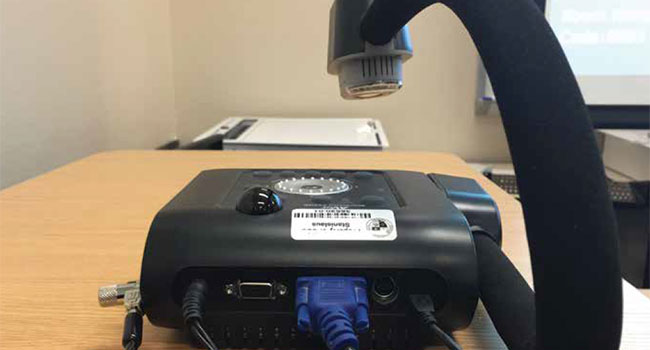
Protecting the Classroom
IT professionals at Stanislaus State needed to streamline access to locked equipment, while deterring theft and keeping devices secure
- By Matt Sumner
- July 01, 2017
SITUATION
California State University, Stanislaus serves a diverse student body of
more than 9,000 at two locations in the Central Valley of California—a
beautiful 228-acre campus in Turlock and the Stockton Center, located
in the city’s historic Magnolia District. Widely recognized for its dedicated
faculty and high-quality academic programs, the university offers
more than 100 majors, minors and areas of concentration, along with
24 master’s degree programs and a doctorate in educational leadership.
Information Technology Consultant Luis Segovia is responsible for
maintenance of the university’s technology and audio visual resources
across campus that support administrative requirements and academic
development. The university has been using a set of older Kensington
MicroSaver locks, specifically in Naraghi Hall of Science since its
opening in 2007, to secure a variety of computing and audio visual
equipment and deter theft.
“A former IT consultant originally purchased individual locks and
keys for individual equipment, making it difficult to sort through
which keys belonged to which locks,” Segovia said. “This can use up a
lot of unnecessary time when we are checking and testing equipment
for maintenance purposes.”
“We have a variety of assets that need protection, including
document and pan to zoom cameras, conference phones
and projectors,” said Segovia. “With the Kensington locks,
we’ve eliminated the need for IT to access this equipment
with multiple individual keys. A master key that allows
access across multiple devices greatly streamlines the
process for us.”
– Luis Segovia, Information Technology Consultant, Stanislaus State
The university was in need of a solution that would not only help
mitigate theft and protect valuable IT and AV assets, but simplify the
locking and unlocking process to improve the efficiency of equipment
maintenance.
“Kensington’s locks provide an extra measure of insurance
that the many assets used in the classroom are safe and
the University’s investment in such equipment is protected,”
said Segovia. “The Master Key solution offers an added
benefit to the IT department, providing ease of use and
simplified access that greatly reduces unnecessary down
time. Kensington has a great solution and we have a lot of
trust in their locks and security offerings.”
– Luis Segovia, Information Technology Consultant, Stanislaus State
SOLUTION
After consulting with a technology integrator, Segovia was introduced
to Kensington’s MicroSaver 2.0 Keyed Laptop Lock, which is part of
the Kensington Master Key Solution.
The MicroSaver 2.0 lock was engineered using patented technologies
and un derwent rigorous testing protocols to create the latest standard
in device security. Because it is part of Kensington’s unique Master
Key system, the locks come with a master key that can be used by
Segovia and other technicians to access the equipment simply and
swiftly. Individual users each still use a unique key for unlocking
equipment.
After holding a series of on-site meetings to learn about Stanislaus
State and understand its requirements for physical security, Kensington
was able to make recommendations for how the university might
deploy the MicrosSaver 2.0 lock across campus and for multiple types
of equipment.
“We have a variety of assets that need protection, including document
and pan to zoom cameras, conference phones, and projectors,”
said Segovia. “With the Kensington locks, we’ve eliminated the need
for IT to access this equipment with multiple individual keys. A master
key that allows access across multiple devices greatly streamlines the
process for us.”
The university is also using the MicroSaver 2.0 lock for protecting a set of laptops that are part of a user checkout
system. When a faculty member checks out a
laptop from the help desk, a MicroSaver 2.0
lock and key are also provided so that the user
can secure the laptop if he or she needs to
walk away for any reason.
The university is using Kensington’s AC12
Security Charging Cabinet to store and charge
the checkout laptops. The cabinet was
designed to secure, power and store multiple
devices at once, with features that make it
flexible and easy to use in different environments.
It holds 12 devices and can safely
charge all 12 devices simultaneously.
BENEFITS
After being introduced to Kensington and its
security products, Segovia was impressed by
the variety of applications where the Micro-
Saver 2.0 locks can be used across campus.
While today they are used in Naraghi Hall of
Science, Segovia plans to extend the locks to
additional buildings in order to protect valuable
equipment, such as projectors, throughout
the campus.
“Kensington’s locks provide an extra measure
of insurance that the many assets used
in the classroom are safe and the university’s
investment in such equipment is protected,”
said Segovia. “The Master Key solution
offers an added benefit to the IT department,
providing ease of use and simplified
access that greatly reduces unnecessary
down time. Kensington has a great solution
and we have a lot of trust in their locks and
security offerings.”
This article originally appeared in the July 2017 issue of Campus Security Today.